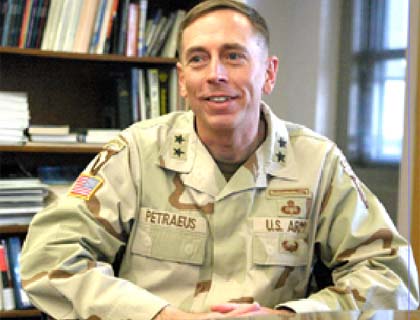KABUL - Just days away from the end of his tour as the supreme military commander in Afghanistan, and the end of a 37-year military career, Gen. David H. Petraeus said he was leaving in the belief that his plan to turn around the war and hand over security to the Afghans could be achieved. "It is very hard, but it is doable," he said in his last scheduled interview before his departure this month. "A number of different elements have to keep coming together to achieve our objectives. Again, we are talking about an objective that is Afghans able to secure and govern themselves with some continued level of support."
General Petraeus, who is widely credited with turning around the war in Iraq, was called in July 2010 to preside over a major expansion of the American military mission in Afghanistan. Now, he is leaving to take a civilian job as director of the Central Intelligence Agency.
He has had command in Afghanistan during a critical year, as 80,000 extra Afghan and international coalition forces were added to the fight against the Taliban and Al Qaeda, leading to intensified fighting and sharply higher casualty numbers. And he is leaving earlier than planned, in the middle of the summer fighting season and before any lasting effects of the so-called troop surge are clear.
Yet the general said signs of progress were beginning to appear. Insurgent attacks were down in May and June compared with the same months in 2010, and July is showing the same trend, he said.
"This just means that they have less capacity; they have been degraded somewhat," he said of the insurgents. "This is the first real indicator — for the first time since 2006 — compared to the previous year, insurgent attack numbers are lower."
But he warned that there would still be tough fighting in the next 15 months before 33,000 surge troops are brought back to the United States, according to the schedule that President Obama laid out in a speech on June 22.
American forces still have to consolidate gains against Taliban insurgents in southern Afghanistan this summer and are pushing into Taliban strongholds in northern Helmand Province, one of the deadliest battlegrounds and the main source of Afghanistan's opium crop. And they still must secure important outlying districts in nearby Kandahar Province that insurgents have used as infiltration routes.
In the winter, the military will shift much of its intelligence and logistical and combat support elements to eastern Afghanistan to focus on the insurgency that filters in from Pakistan's tribal areas and runs along Afghanistan's eastern border provinces, General Petraeus said.
The campaign will not be as intensive a fight for every village and vineyard as it was last fall in southern Afghanistan, but will rest largely on the buildup of Afghan Army and police forces to guard the border, block infiltration routes and strengthen communities and local government, he said.
American forces are to provide the critical extras, namely helicopters and forces to support more intelligence gathering, surveillance, targeted operations and mentoring of Afghan forces.
"President Obama has said Afghan forces will stand up but will not stand alone; there is a sense of continued commitment," he said. "Fifteen months is a long period of time."
Two remaining problem areas are the remote provinces of Kunar and Nuristan, in northeastern Afghanistan, where 50 to 100 members of Al Qaeda continue to find sanctuary, and where Afghan and American forces are very thinly spread, he acknowledged. The coalition can continue to disrupt the insurgents with operations, but ultimately the solution will have to be a "local solution," he said.
Central to the plan that General Petraeus is leaving to his successor is the program to recruit and train village men into local police forces to guard their communities and strengthen local governments. The program is still in its infancy; so far, only 7,000 of a planned 30,000 men are operational.

